Cabletron Systems Switches User manual
- Category
- Bridges & repeaters
- Type
- User manual
This manual is also suitable for

Cabletron Systems
Networking Guide
Workgroup Solutions


i
Notice
Notice
Cabletron Systems reserves the right to make changes in specifications and other information
contained in this document without prior notice. The reader should in all cases consult Cabletron
Systems to determine whether any such changes have been made.
The hardware, firmware, or software described in this manual is subject to change without notice.
IN NO EVENT SHALL CABLETRON SYSTEMS BE LIABLE FOR ANY INCIDENTAL, INDIRECT,
SPECIAL, OR CONSEQUENTIAL DAMAGES WHATSOEVER (INCLUDING BUT NOT LIMITED
TO LOST PROFITS) ARISING OUT OF OR RELATED TO THIS MANUAL OR THE INFORMATION
CONTAINED IN IT, EVEN IF CABLETRON SYSTEMS HAS BEEN ADVISED OF, KNOWN, OR
SHOULD HAVE KNOWN, THE POSSIBILITY OF SUCH DAMAGES.
Copyright
1996 by Cabletron Systems, Inc. All rights reserved.
Printed in the United States of America.
Order Number: 9032094 January 1997
Cabletron Systems, Inc.
P.O. Box 5005
Rochester, NH 03866-5005
Cabletron Systems
,
SPECTRUM
,
BRIM
,
FNB
,
LANVIEW
,
Multi Media Access Center
, are
registered trademarks, and
Bridge/Router Interface Module
,
BRIM-A6
,
BRIM-A6DP
,
BRIM-E6
,
BRIM-E100
,
BRIM-F6
,
BRIM-W6
,
EPIM
,
EPIM-A
,
EPIM-C
,
EPIM-F1
,
EPIM-F2
,
EPIM-F3
,
EPIM-T
,
EPIM-X
,
APIM
,
APIM-11
,
APIM-21
,
APIM-22
,
APIM-29
,
APIM-67
,
FPIM
,
FPIM-00
,
FPIM-01
,
FPIM-02
,
FPIM-04
,
FPIM-05
,
FPIM-07
,
TPIM
,
TPIM-F2
,
TPIM-F3
,
TPIM-T1
,
TPIM-T2
,
TPIM-T4
,
WPIM
,
WPIM-T1
,
WPIM-DDS
,
WPIM-E1
,
WPIM-SY
,
MicroMMAC
,
MMAC
,
MMAC-Plus
,
SEH
,
SEHI
,
STH
,
STHI
,
FN10
,
FN100
,
MR9T
,
MR9T-C
,
MR9T-E
,
ESX-1320
,
ESX-1380
,
NBR-220
,
NBR-420
,
NBR-620
,
SEH100TX
,
SEHI100-TX
,
SPECTRUM Element Manager
,
SPECTRUM for Open Systems
,
are trademarks of Cabletron Systems, Inc.
All other product names mentioned in this manual may be trademarks or registered trademarks of
their respective companies.

Notice
ii

iii
Chapter 1 Introduction
Using This Guide.........................................................................................................................1-1
Document Organization .............................................................................................................1-2
Document Conventions..............................................................................................................1-3
Warnings and Notifications ................................................................................................1-3
Formats ..................................................................................................................................1-3
Additional Assistance .................................................................................................................1-3
Related Documentation ..............................................................................................................1-4
Chapter 2 Review of Networking
Ethernet.........................................................................................................................................2-2
Fast Ethernet.................................................................................................................................2-3
Token Ring....................................................................................................................................2-5
Chapter 3 The Workgroup Approach
Standalones...................................................................................................................................3-1
Standalones, the Original Networking Devices...............................................................3-2
Management of Standalones...............................................................................................3-3
Limitations of Standalones..................................................................................................3-3
Stackables......................................................................................................................................3-4
How Stacks Work .................................................................................................................3-5
Intelligence in the Stack.......................................................................................................3-6
Internetworking for Stacks..................................................................................................3-6
Limitations of Stacks............................................................................................................3-7
Chapter 4 PIMs and BRIMs
Port Interface Modules................................................................................................................4-1
Types of PIMs........................................................................................................................4-2
Bridge/Router Interface Modules.............................................................................................4-8
Types of BRIMs .....................................................................................................................4-8
Contents

Contents
iv
Chapter 5 Network Design
The Role of the Workgroup ........................................................................................................5-2
Workgroup Establishment Criteria....................................................................................5-3
Selecting Workgroup Technologies....................................................................................5-9
Creating a Manageable Plan.....................................................................................................5-10
Logical Layout.....................................................................................................................5-10
Fault Aversion .....................................................................................................................5-12
Network Maps and Record Keeping ...............................................................................5-14
Network Expandability.............................................................................................................5-15
The Workgroup as the Network..............................................................................................5-16
The Workgroup in the Larger Network..................................................................................5-16
What Is a Backbone?...........................................................................................................5-17
Methods of Configuring Backbones ................................................................................5-17
Choosing Backbone Technologies ....................................................................................5-21
Chapter 6 Ethernet
Ethernet Workgroup Devices.....................................................................................................6-2
Shared Devices......................................................................................................................6-2
Switched Devices..................................................................................................................6-4
Ethernet Workgroup Design ......................................................................................................6-5
The Home Office...................................................................................................................6-5
The Small Office..................................................................................................................6-11
The Remote Office ..............................................................................................................6-16
The High-End Department ...............................................................................................6-19
Permutations .......................................................................................................................6-24
Chapter 7 Fast Ethernet
Fast Ethernet Workgroup Devices.............................................................................................7-1
Shared Devices......................................................................................................................7-1
Switched Devices..................................................................................................................7-2
Fast Ethernet Workgroup Design ..............................................................................................7-3
Small Offices..........................................................................................................................7-3
High-End Department .........................................................................................................7-6
Fast Ethernet as a Backbone................................................................................................7-9
Chapter 8 Token Ring
Token Ring Workgroup Devices................................................................................................8-1
Shared Devices......................................................................................................................8-1
Token Ring Workgroup Design .................................................................................................8-3
Small Office............................................................................................................................8-3

v
Contents
Appendix A Charts and Tables
Workgroup Design Tables .........................................................................................................A-1
Ethernet.................................................................................................................................A-1
Fast Ethernet.........................................................................................................................A-3
Token Ring............................................................................................................................A-4
PIMs and BRIMs..................................................................................................................A-5
Networking Standards and Limitations..................................................................................A-8
Ethernet.................................................................................................................................A-8
Fast Ethernet.........................................................................................................................A-9
Token Ring..........................................................................................................................A-10
FDDI ....................................................................................................................................A-12

Contents
vi

1-1
Chapter 1
Introduction
Using This Guide
The
Cabletron Systems Networking Guide - Workgroup Solutions
is intended
to provide much of the information necessary to allow Network Managers to
design and evaluate workgroup networks using the Cabletron Systems family of
standalone and stackable networking products. This guide also provides the
methods for associating these workgroups into larger networks or incorporating
them into existing facility networks.
This document was written with the assumption that the reader has some
familiarity with four networking technologies; Ethernet, Fast Ethernet, Token
Ring, and FDDI. If you are unfamiliar with these technologies, Cabletron Systems
produces instructional and reference materials that may be of assistance in
learning these networking technologies. The available instructional materials are
referred to in
Related Documentation
, later in this chapter. For those already
familiar with the Ethernet, Fast Ethernet, and Token Ring technologies, a brief
refresher in the main design-specific aspects of these technologies is provided in
later chapters.
NOTE
This document assumes that the reader has read the
Cabletron
Systems Networking Guide - MMAC-FNB Solutions
. The
document is available on the Cabletron Systems Hardware
Manuals CD-ROM. If you are unable to locate a copy of that
document, you may also order a printed version of any
document listed above from Cabletron Systems.

Introduction
1-2 Document Organization
Document Organization
The following summarizes the organization of this manual:
Chapter 1,
Introduction
, provides basic information about this document,
including the organization and format of the document.
Chapter 2,
Review of Networking
, describes the important design restrictions
and characteristics of three basic networking technologies.
Chapter 3,
The Workgroup Approach
, explains the history and product
philosophy behind standalone and stackable workgroup networking devices.
Chapter 4,
PIMs and BRIMs
, details the operation and use of Cabletron Systems’
various speciality interface modules.
Chapter 5,
Network Design
, covers the information and decisions involved in the
identification of networking needs and formation of solutions which meet those
needs.
Chapter 6,
Ethernet
, explains and illustrates the network design process involved
in creating Ethernet workgroups.
Chapter 7,
Fast Ethernet
, provides information and examples that show the
design issues that must be dealt with when configuring a Fast Ethernet network.
Chapter 8,
Token Ring
, supplies design and configuration information for Token
Ring workgroup solutions.
Appendix A,
Charts and Tables
, provides a centralized source for the design
tables found throughout this document, and useful information relating to the
networking technologies that are discussed.

Document Conventions 1-3
Introduction
Document Conventions
Warnings and Notifications
Formats
References to chapters or sections within this document are printed in
boldface
type.
References to other Cabletron Systems publications or documents are printed in
italic
type.
Additional Assistance
The design of a network is a complex and highly specialized process. Due to the
different nature of each and every cabling installation and the special problems
and concerns raised by any facility, there may be aspects of network design that
are not covered in this guide.
If you have doubts about your network design, or if you require installation
personnel to perform the actual installation of hardware and cabling, Cabletron
Systems maintains a staff of network design personnel and highly-trained cabling
and hardware installation technicians. The services of the Networking Services
group are available to customers at any time. If you are interested in obtaining
design assistance or a network installation plan from the Networking Services
group, contact your Cabletron Systems Sales Representative.
In addition to the availability of Networking Services, the Cabletron Systems
Technical Support department is available to answer customer questions
regarding existing Cabletron Systems networks or planned expansion issues.
Contact Cabletron Systems at (603) 332-9400 to reach the Technical Support
department with any specific product-related questions you may have.
NOTE
Note
symbol. Calls the reader’s attention to any item of
information that may be of special importance.

Introduction
1-4 Related Documentation
Related Documentation
The following publications may be of assistance to you in the design process.
Several of these documents present information supplied in this guide in greater
or lesser detail than they are presented here.
• Cabletron Systems Networking Guide - MMAC-FNB Solutions
• Cabletron Systems Cabling Guide
• Cabletron Systems Ethernet Technology Guide
• Cabletron Systems Token Ring Technology Guide
• Cabletron Systems FDDI Technology Guide
For additional product or other information, visit us at
http://www.cabletron.com or contact Cabletron Systems by phone at
(603) 332-9400.

2-1
Chapter 2
Review of Networking
This chapter discusses the defining characteristics of three major Local Area Network (LAN)
technologies.
Before discussing the selection of networking hardware for workgroup design, an
understanding of the major standardized networking technologies available for
these designs is necessary. This chapter provides a brief review of the three major
networking technologies that are to be treated in this document: Ethernet, Fast
Ethernet, and Token Ring.
This section is intended to be a review of the most important aspects of these
technologies, and is not expected to stand alone. For more detailed information,
Cabletron Systems publishes a series of other documents that treat these
technologies in greater detail. For introductory information, the Cabletron Systems
Networking Guide - MMAC-FNB Solutions manual provides extensive training
information in the basics of these technologies. Further technical detail is
available in the Cabletron Systems Technology Overview Guides. A list of associated
publications, including these titles, is supplied in the Related Documentation
section of Chapter 1.

Review of Networking
2-2 Ethernet
Ethernet
Ethernet is a local area networking technology that was initially developed in the
1970s by the Xerox Corporation. It is based on the principles of workstations
being responsible for their own transmissions and operation. It is sometimes
referred to as 802.3 networking, in reference to the number of the IEEE standards
body which subsumes all Ethernet operations.
Ethernet networks provide an operating bandwidth of 10 megabits per second
(Mbps). Bandwidth is a networking term which describes the operating speed of a
technology. In the case of Ethernet, a perfectly operating, theoretical Ethernet
network, can move 10,000,000 bits of data each second between two stations on
the network.
Ethernet is a Carrier Sense Multiple Access/Collision Detection (CSMA/CD)
LAN technology. Stations on an Ethernet LAN can access the network at any time.
Before sending data, Ethernet stations “listen” to the network to see if it is already
in use. If so, the station wishing to transmit waits and examines the network again
later. If the network is not in use, the station transmits. A collision occurs when
two stations listen for network traffic, “hear” none, then transmit simultaneously.
In this case, both transmissions are damaged and the stations, sensing this
collision, must retransmit at some later time. Backoff algorithms determine when
the colliding stations retransmit.
Ethernet is a broadcast network. In other words, all stations see all frames
(collections of data), regardless of if they are an intended destination. Each station
must examine received frames to determine if it is the destination. If so, the frame
is passed to a higher protocol layer for appropriate processing.
Ethernet transmits data frames over a physical medium of coaxial, fiber optic, or
twisted pair cable. The coaxial and fiber optic cable typically represents the
backbone of an Ethernet LAN, while twisted pair is used as a low cost connection
from the backbone to the desktop.
Ethernet LANs have the following media restrictions in order to adhere to IEEE
802.3 standards:
• Bus Length: The maximum bus length for an Ethernet LAN for all media types
are as follows:
- 500 m for 10BASE5 coaxial cable
- 185 m for 10BASE2 coaxial cable
- 2,000 m for multi mode fiber optic (10BASE-F) cable
(5,000 m for single mode)
- 100 m for twisted pair (10BASE-T) cable.
NOTE
These media lengths are not precise values. Actual maximum
cable lengths are strongly dependent on the physical cable
characteristics.

Fast Ethernet 2-3
Review of Networking
• AUI Length: The maximum Attachment Unit Interface (AUI) cable length is
50 m for connections from a transceiver to an Ethernet device. The 50 m
distance is the allowable maximum for standard AUI, while a maximum
length of 16.5 m has been set for office AUI.
• Number of Stations per Network: IEEE standards specify that the maximum
allowable number of stations per un-bridged network is 1,024, regardless of
media type. The 10BASE5 networks are allowed 100 taps per segment, while
10BASE2 networks are allowed 30 taps per segment with a maximum of
64 devices per tap each. (Fiber optic and twisted pair cable are point-to-point
media which do not allow taps or branches).
• Maximum Signal Path: The maximum allowable signal path is 4 repeaters, 5
segments (with at least 2 segments being unpopulated Inter-Repeater Links),
and 7 bridges for all media types.
There are other limitations involved in the IEEE 802.3 standard and the various
cable specifications, which are more detailed and complex. These limitations are
covered in detail in the Cabletron Systems Cabling Guide and the Cabletron Systems
Ethernet Technology Overview.
Fast Ethernet
Fast Ethernet is a networking technology that grew out of the popular Ethernet
technology described above. Fast Ethernet uses the same CSMA/CD media
access method and basic network operation. The main differences between
Ethernet and Fast Ethernet are the available bandwidth and media limitations.
Fast Ethernet increases the available bandwidth of a single network to 100 Mbps,
ten times faster than normal Ethernet. This increase in transmission speed,
however, comes at a cost to the flexibility of the network. By increasing the speed
of transmission by a factor of 10, the required characteristics of Ethernet links
were likewise reduced.
Fast Ethernet networks only support UTP and multimode fiber optics as standard
transmission media. The two standards for these media are 100BASE-TX for
Category 5 UTP, and 100BASE-FX for multimode fiber optics.
The IEEE 802.3u standard defines two different types of Fast Ethernet repeaters:
Classes I and II. All Cabletron Systems Fast Ethernet products discussed in this
document are Class I repeaters. A Fast Ethernet network designed with Class I
repeaters allows a signal path from one station, through a Fast Ethernet link, to a
Class I repeater, through another Fast Ethernet link, to a receiving station. No
other Class I repeaters may be placed in this signal path.
NOTE
If it becomes necessary to extend the network beyond the IEEE
limit of 1,024 devices, a bridge can be used to connect another
full specification Ethernet network.

Review of Networking
2-4 Fast Ethernet
This signal path, two end stations and the repeaters between them, is called the
network radius. Unlike standard Ethernet networks, Fast Ethernet networks have
a maximum network radius that may restrict the lengths of station cabling to less
than the maximum allowable distances for single links. Typically, network radius
calculations are only important when mixing 100BASE-TX and 100BASE-FX
networks. The maximum network radius limits are provided later in this section.
As the imposition of a maximum network radius on mixed 100BASE-TX and
100BASE-FX networks severely limits the design options of Fast Ethernet
networks, Fast Ethernet devices may incorporate buffered uplinks. A buffered
uplink is a Fast Ethernet port on a repeater which allows the repeater to ignore the
collision domain of the uplink. This allows the buffered uplink to be a
maximum-length segment even in mixed media environments.
Fast Ethernet LANs must meet the following media and network restrictions in
order to adhere to IEEE standards:
• Cabling Quality: All 100BASE-TX links require UTP cabling meeting or
exceeding the Telecommunications Industry Association (TIA) Category 5
specification. The link must be compliant from end to end, including all
connectors and patch panels.
• Link Length: No single link in the Fast Ethernet network may exceed the
limitations given below, including jumper cables and patch cables:
- 100 m for 100BASE-TX networks
- 400 m for 100BASE-FX networks
• Network Radius: Network radius is the distance traveled from the station with
the longest media link to the Fast Ethernet repeater and out to the station with
the second-longest media link. In order to meet IEEE standards, Fast Ethernet
networks constructed with Class I repeaters must not exceed the following
maximum network radii:
- 200 m for homogenous 100BASE-TX networks
- 260 m for mixed 100BASE-TX and 100BASE-FX networks
- 272 m for homogenous 100BASE-FX networks
NOTE
A buffered uplink is considered a bridged or switched
connection only for purposes of determining cable length.
NOTE
These media lengths are fixed values. Deviation from these
maximums will lead to poor network performance.

Token Ring 2-5
Review of Networking
Fast Ethernet networks designed using Class II repeaters may not exceed the
following maximum network radii:
- 200 m for homogenous 100BASE-TX networks
- 320 m for homogenous 100BASE-FX networks
• Buffered Uplinks: If a buffered uplink is used to make a connection, the
allowable length of the buffered uplink itself does not change, but the
maximum network radius calculations will change. Assuming that the
buffered uplink is the longest link in the repeater radius, the maximum
allowable network radius will change to the values given below:
- 500 m for mixed 100BASE-TX and buffered 100BASE-FX uplink
- 800 m for homogenous 100BASE-FX networks
• Number of Stations per Network: IEEE standards specify that the maximum
allowable number of stations per single-segment network is 1,024, regardless
of media type.
• Maximum Signal Path: The maximum allowable signal path for a Fast
Ethernet network is one Class I repeater, two segments for all media types. The
use of bridges, switches, or routers can allow the creation of larger networks.
Token Ring
Token Ring network operation is based on the principle that the operation of the
entire network determines when a station may transmit and when it will receive.
Stations monitor one another, and one station acts as an overall ring monitor,
keeping track of important statistics. Token Ring stations are connected to one
another in a predetermined order, and network frames pass from one station to
the next, following that order. A specialized network frame, called a token, is
passed around the ring at regular intervals. The transmission of the token helps
establish some of the operational statistics for the network, and receiving it allows
a station to transmit.
The Token Ring technology is designed to operate at either of two speeds: 4 Mbps
or 16 Mbps. This speed selection is made when the network is installed, and the
speed must apply equally to all stations (you may not split a ring into groups of
16 Mbps and 4 Mbps stations).
NOTE
If it becomes necessary to extend the network beyond the IEEE
limit of 1,024 devices, a bridge or switch can be used to
connect another full specification Fast Ethernet network.

Review of Networking
2-6 Token Ring
The transmission and reception of the token determines the amount of time that
any station will have to transmit data during its turn, offering a measure of
predictability not available in Ethernet or Fast Ethernet. This predictability also
allows Token Ring networks to incorporate special error-detection and correction
functions which can locate and correct network problems without human
intervention.
The predictability of the Token Ring technology also leads to a number of
limitations on the number of stations that can be connected to a network and the
maximum cable lengths that a signal may be passed across. Since the stations are
configured to expect reception of the token at certain increments of time,
exceeding the maximum number of stations or the maximum length of cabling
between stations can delay the token’s progress, causing the Token Ring network
to suffer errors and poor performance.
In order to stretch the capabilities of a Token Ring network, various technologies
are available which extend the distance a signal can travel before suffering
degradation or loss of signal timing due to cable lengths or high station count.
One method of increasing the resilience of a Token Ring network is the
incorporation of what is called “active circuitry.” Token Ring station ports with
this active circuitry regenerate, strengthen, and re-time any Token Ring signal
received by or transmitted from that interface.
Token Ring devices can also extend the distance that a ring can cover through the
use of Ring-In/Ring-Out, or RI/RO cables. RI/RO cables are designed only to
make connections between Token Ring concentrator devices, and extend the area
that a ring can support by allowing long-distance links to other Token Ring
devices.
NOTE
All Cabletron Systems stackable and standalone Token Ring
products incorporate active circuitry on all ports.
NOTE
RI/RO connections are not bridge or switch interfaces. They do
not create a new Token Ring network.

Token Ring 2-7
Review of Networking
Token Ring networks can use a variety of physical cabling, including Unshielded
Twisted Pair (UTP), Shielded Twisted Pair (STP), or fiber optic cabling. The
characteristics of the various cables can directly impact the operational limitations
of a Token Ring network which uses a particular media.
• Lobe Cable Lengths for 4 Mbps Token Rings: The operation of a 4 Mbps Token
Ring network imposes some relatively generous limitations on the maximum
length of any station cable (also called a lobe cable) connected to an active port
in the network as shown in the following list:
- IBM Types 1, 2 STP: 300 m
- IBM Types 6, 9 STP: 200 m
- Category 5 UTP: 250 m
- Categories 3, 4 UTP: 200 m
- Multimode Fiber Optics: 2000 m
- Single Mode Fiber Optics: 2000 m
• Lobe Cable Lengths for 16 Mbps Token Rings: 16 Mbps Token Ring networks
also impose limitations on the maximum length of any media connected to an
active port as shown in the following list:
- IBM Types 1, 2 STP: 150 m
- IBM Types 6, 9 STP: 100 m
- Category 5 UTP: 120 m
- Categories 3, 4 UTP: 100 m
- Multimode Fiber Optics: 2000 m
- Single Mode Fiber Optics: 2000 m
• RI/RO Cable Lengths for 4 Mbps Token Rings: 4 Mbps Token Ring networks
also require that Ring-In/Ring-Out (RI/RO) connections be no longer than a
certain amount. This amount is dependent upon the media being used for the
RI/RO connection as shown in the following list:
- IBM Types 1, 2 STP: 770 m
- Category 5 UTP: 250 m
- Categories 3, 4 UTP: 200 m
- Multimode Fiber Optics: 2000 m
- Single Mode Fiber Optics: 2000 m
• RI/RO Cable Lengths for 16 Mbps Token Rings: 16 Mbps Token Ring networks
also require that Ring-In/Ring-Out (RI/RO) connections not exceed the
lengths given below:
- IBM Types 1, 2 STP: 346 m
- Category 5 UTP: 120 m
- Categories 3, 4 UTP: 100 m
- Multimode Fiber Optics: 2000 m
- Single Mode Fiber Optics: 2000 m

Review of Networking
2-8 Token Ring
• Number of Stations Per 4 Mbps Token Ring: In the same fashion as the limits
imposed on cable lengths due to the operating speed of the network and type
of cabling used, there are limitations on the number of stations that may be
connected to a single ring using active circuitry. If these numbers are exceeded,
a bridge, switch, or other segmentation device must be used to break the ring
into two or more smaller rings as detailed in the list below:
- IBM Types 1, 2 STP: 250 stations
- IBM Types 6, 9 STP: 250 stations
- Category 5 UTP: 150 stations
- Categories 3, 4 UTP: 150 stations
- Multimode Fiber Optics: 250 stations
- Single Mode Fiber Optics: 250 stations
• Number of Stations Per 16 Mbps Token Ring: The limitation on the number of
stations in the Token Ring also applies to 16 Mbps networks. In one case, the
number of stations supported by these faster Token Ring networks is
significantly lower than the number supported by the 4 Mbps rings.
- IBM Types 1, 2 STP: 250 stations
- IBM Types 6, 9 STP: 136 stations
- Category 5 UTP: 150 stations
- Categories 3, 4 UTP: 150 stations
- Multimode Fiber Optics: 250 stations
- Single Mode Fiber Optics: 250 stations
The Token Ring limitations that are described above are summarized for your
ease of reference in Table 2-1. This table is also repeated in Appendix A, Charts
and Tables.
a. IBM Type 6 cable is recommended for use as jumper cabling only and should not be used for
facility cabling installations.
Table 2-1. Token Ring Maximums
Media
Cable
Type
Max # of Stations
Max Lobe Cable
Length
4 Mbps 16 Mbps 4 Mbps 16 Mbps
STP IBM Types 1, 2 250 250 300 m 150 m
IBM Types 6, 9
a
250 136 200 m 100 m
UTP Category 5 150 150 250 m 120 m
Categories 3, 4 150 150 200 m 100 m
Fiber Optics Multimode 250 250 2000 m 2000 m
Single Mode 250 250 2000 m 2000 m
Page is loading ...
Page is loading ...
Page is loading ...
Page is loading ...
Page is loading ...
Page is loading ...
Page is loading ...
Page is loading ...
Page is loading ...
Page is loading ...
Page is loading ...
Page is loading ...
Page is loading ...
Page is loading ...
Page is loading ...
Page is loading ...
Page is loading ...
Page is loading ...
Page is loading ...
Page is loading ...
Page is loading ...
Page is loading ...
Page is loading ...
Page is loading ...
Page is loading ...
Page is loading ...
Page is loading ...
Page is loading ...
Page is loading ...
Page is loading ...
Page is loading ...
Page is loading ...
Page is loading ...
Page is loading ...
Page is loading ...
Page is loading ...
Page is loading ...
Page is loading ...
Page is loading ...
Page is loading ...
Page is loading ...
Page is loading ...
Page is loading ...
Page is loading ...
Page is loading ...
Page is loading ...
Page is loading ...
Page is loading ...
Page is loading ...
Page is loading ...
Page is loading ...
Page is loading ...
Page is loading ...
Page is loading ...
Page is loading ...
Page is loading ...
Page is loading ...
Page is loading ...
Page is loading ...
Page is loading ...
Page is loading ...
Page is loading ...
Page is loading ...
Page is loading ...
Page is loading ...
Page is loading ...
Page is loading ...
Page is loading ...
Page is loading ...
Page is loading ...
Page is loading ...
Page is loading ...
Page is loading ...
Page is loading ...
Page is loading ...
Page is loading ...
Page is loading ...
Page is loading ...
Page is loading ...
Page is loading ...
Page is loading ...
Page is loading ...
Page is loading ...
Page is loading ...
Page is loading ...
Page is loading ...
Page is loading ...
Page is loading ...
Page is loading ...
Page is loading ...
Page is loading ...
Page is loading ...
Page is loading ...
Page is loading ...
Page is loading ...
Page is loading ...
Page is loading ...
Page is loading ...
Page is loading ...
Page is loading ...
Page is loading ...
Page is loading ...
Page is loading ...
Page is loading ...
Page is loading ...
Page is loading ...
Page is loading ...
Page is loading ...
Page is loading ...
Page is loading ...
Page is loading ...
Page is loading ...
-
 1
1
-
 2
2
-
 3
3
-
 4
4
-
 5
5
-
 6
6
-
 7
7
-
 8
8
-
 9
9
-
 10
10
-
 11
11
-
 12
12
-
 13
13
-
 14
14
-
 15
15
-
 16
16
-
 17
17
-
 18
18
-
 19
19
-
 20
20
-
 21
21
-
 22
22
-
 23
23
-
 24
24
-
 25
25
-
 26
26
-
 27
27
-
 28
28
-
 29
29
-
 30
30
-
 31
31
-
 32
32
-
 33
33
-
 34
34
-
 35
35
-
 36
36
-
 37
37
-
 38
38
-
 39
39
-
 40
40
-
 41
41
-
 42
42
-
 43
43
-
 44
44
-
 45
45
-
 46
46
-
 47
47
-
 48
48
-
 49
49
-
 50
50
-
 51
51
-
 52
52
-
 53
53
-
 54
54
-
 55
55
-
 56
56
-
 57
57
-
 58
58
-
 59
59
-
 60
60
-
 61
61
-
 62
62
-
 63
63
-
 64
64
-
 65
65
-
 66
66
-
 67
67
-
 68
68
-
 69
69
-
 70
70
-
 71
71
-
 72
72
-
 73
73
-
 74
74
-
 75
75
-
 76
76
-
 77
77
-
 78
78
-
 79
79
-
 80
80
-
 81
81
-
 82
82
-
 83
83
-
 84
84
-
 85
85
-
 86
86
-
 87
87
-
 88
88
-
 89
89
-
 90
90
-
 91
91
-
 92
92
-
 93
93
-
 94
94
-
 95
95
-
 96
96
-
 97
97
-
 98
98
-
 99
99
-
 100
100
-
 101
101
-
 102
102
-
 103
103
-
 104
104
-
 105
105
-
 106
106
-
 107
107
-
 108
108
-
 109
109
-
 110
110
-
 111
111
-
 112
112
-
 113
113
-
 114
114
-
 115
115
-
 116
116
-
 117
117
-
 118
118
-
 119
119
-
 120
120
-
 121
121
-
 122
122
-
 123
123
-
 124
124
-
 125
125
-
 126
126
-
 127
127
-
 128
128
-
 129
129
-
 130
130
-
 131
131
-
 132
132
Cabletron Systems Switches User manual
- Category
- Bridges & repeaters
- Type
- User manual
- This manual is also suitable for
Ask a question and I''ll find the answer in the document
Finding information in a document is now easier with AI
Related papers
-
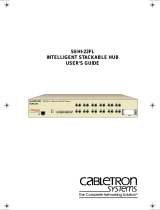 Cabletron Systems SEHI-22FL User manual
Cabletron Systems SEHI-22FL User manual
-
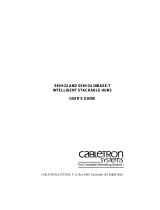 Cabletron Systems SEHI-22 User manual
Cabletron Systems SEHI-22 User manual
-
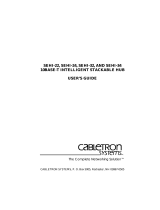 Cabletron Systems TPT User manual
Cabletron Systems TPT User manual
-
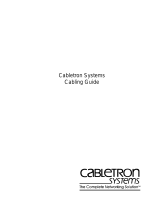 Cabletron Systems 100BASE-FX Specification
Cabletron Systems 100BASE-FX Specification
-
Enterasys Networks EPIM F3 User manual
-
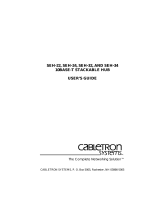 Cabletron Systems SEH-34 User manual
Cabletron Systems SEH-34 User manual
-
Cabletron Systems SEHI100TX-22 100BASE-T User manual
-
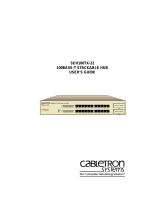 Cabletron Systems SEH100TX-22 User manual
Cabletron Systems SEH100TX-22 User manual
-
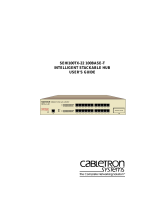 Cabletron Systems SEHI100TX-22 HubSTACK User manual
Cabletron Systems SEHI100TX-22 HubSTACK User manual
-
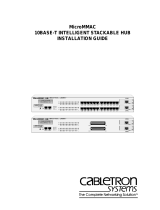 Cabletron Systems MicroMMAC-24ES Installation guide
Cabletron Systems MicroMMAC-24ES Installation guide
Other documents
-
KTI Networks KT-10T User manual
-
Enterasys Networks FN 100 User manual
-
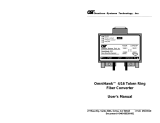 Omnitron Systems Technology OmniHawk User manual
Omnitron Systems Technology OmniHawk User manual
-
HP AdvanceStack Router 230 Installation guide
-
Repotec RP-1649RE Owner's manual
-
Black Box LE4203A-SC Installation and User Manual
-
Intel 100BASE-T4 User manual
-
Intel Network Card PCLA2152B User manual
-
Allied Telesyn International Corp FS716L Installation guide
-
Snom M1 Quick Installation Guide












































































































































